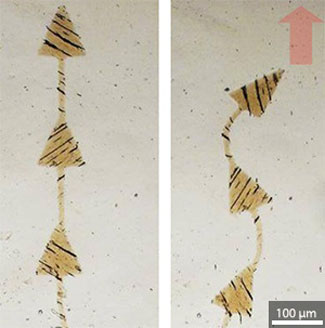| Nov 07, 2011 |
Polymers embedded with nanoparticles learn to dance
|
|
(Nanowerk News) Polymers are convenient instruments for producing mechanical motion at the microscale through their ability to change shape and orientation in response to electric fields, heat and light. Mixing magnetic materials into the polymers also makes it possible for them to respond to magnetic fields. However, the types of motion achievable using these stimuli have so far been restricted to simple movements such as bending, rotation and linear translation.
|
|
Sunghoon Kwon and colleagues from Seoul National University in Korea have now developed a way of fabricating magnetic polymer composites that allows for highly complex motion in response to simple applied magnetic fields ("Programming magnetic anisotropy in polymeric microactuators").
|
 |
| A microactuator consisting of a polymer embedded with magnetic nanoparticles (dark lines).
|
|
The approach taken by Kwon and his colleagues involves mixing superparamagnetic nanoparticles into a polymer and then applying a magnetic field to the mixture. Because the polymer is uncured and fluid, the nanoparticles quickly align themselves with the applied magnetic field. Exposing the polymer to ultraviolet light then freezes the nanoparticles into place, and by exposing only portions of the polymer to light at a time, and reorienting the magnetic field between exposures, nanoparticles in different portions of the finished structure can be aligned in different directions.
|
|
Using this procedure, the researchers designed structures that responded to simple magnetic fields in complex ways. For example, a structure consisting of four triangles, each embedded with magnetic nanoparticles oriented in different directions (see image), underwent twisting in different directions to produce an 'S' shape when subject to a vertical magnetic field. Re-orienting the magnetic field caused the S structure to rotate accordingly. Kwon and his colleagues were able to demonstrate a variety of complex motions, including a tweezer action and a micro-robot that crawled along a surface in a worm-like manner.
|
|
By programming functionality directly into the polymer, this novel fabrication technique achieves complex movement without the need for locally varying magnetic fields, which on the microscale would involve large gradients that would be difficult to create, or complex actuating structures attached to the polymers. The technology is expected to find use in microfluidics and biotechnology, and Kwon says that his group already has plans to use it to manufacture biomimetic micro-robots.
|

